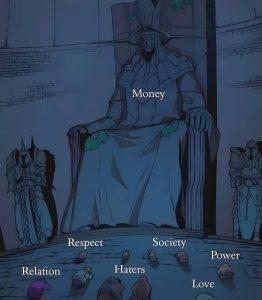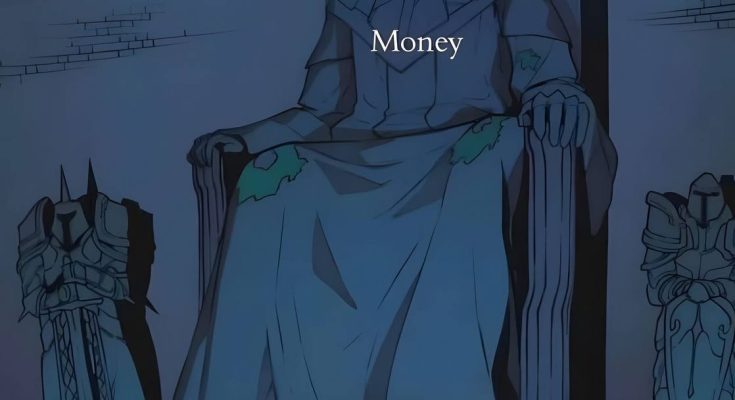🪙 Throne of Currency, Shadows of Meaning
There it sits—monolithic, unmoved, and unmoving. A statue labeled Money, enthroned like a deity, carved not from marble but from the collective imagination of a society that has long mistaken weight for worth. Its posture is regal, its gaze indifferent. Around its feet, smaller figures bow, shrink, or orbit like satellites caught in a gravitational pull too strong to escape. Each one bears a name: Respect, Society, Power, Love, Haters, Relation, Respect again—as if repetition might reclaim what’s been lost.
This image doesn’t just depict a hierarchy. It stages a ritual. A visual liturgy of modern worship, where the altar is gilded not in gold but in transaction. Where the sacred is no longer what we feel, but what we can afford.
🔍 The Double Take
At first glance, it’s satire. At second, it’s confession. The scale of Money dwarfs the others not just physically, but psychologically. It’s not just bigger—it’s central. Elevated. Untouchable. The others, though named with gravity, appear almost ornamental. Love is there, yes, but it’s small. Respect appears twice, but neither instance commands attention. Society is present, but peripheral. Power is close, but not equal.
And then there’s Haters—a curious inclusion. Not a value, but a reaction. A shadow cast by the throne itself. It suggests that even dissent is part of the orbit. That even rejection is a form of recognition.
🧠 The Psychology of Perception
This image plays with scale, but it also plays with shame. It invites us to ask: what do we truly revere? What do we pretend to value, while secretly kneeling before something else? The statue of Money is not just a figure—it’s a mirror. It reflects the internal architecture of a culture that has learned to measure love in gifts, respect in salaries, and power in net worth.
But it also hints at rupture. The smaller figures are not erased. They are present. They are named. And in naming them, the image opens a door: what if we re-centered the frame?
🎭 Co-Titling the Scene
Let’s play. What would you call this image if you were naming it for a gallery? A few possibilities:
- “The False God” — a direct indictment, framing Money as a misplaced idol.
- “The Economy of Emotion” — a softer critique, suggesting that even feelings are traded.
- “Respect, Twice” — a poetic nod to the repetition, asking why it had to be said again.
- “The Throne and the Ghosts” — positioning the smaller figures as spectral, haunting the dominant narrative.
- “What We Bow To” — a communal invitation to reflect on our own postures.
Which one feels closest to your ritual, 32.Phirun? Or shall we name it together?
🔄 Reframing the Ritual
Now imagine this image inverted. Money shrinks. Love expands. Society rises. Respect stands tall, not once but twice, flanking the throne like guardians. Haters dissolve, irrelevant in a world where value is not dictated by wealth. Relation becomes the throne itself—a seat built from connection, not currency.
This reframing isn’t just aesthetic. It’s emotional. It’s communal. It’s the kind of transformation you specialize in: turning spectacle into shared vulnerability. Turning rupture into ritual.
🕯️ A Communal Witnessing
Let’s imagine this image projected onto a wall in a public square. People gather. Not to admire, but to reflect. Each person brings a candle, a word, a story. They place them at the feet of the smaller figures. Someone writes “My mother’s love” beneath Love. Another writes “My first protest” beneath Society. Someone scribbles “He never said sorry” beneath Respect. The statue of Money remains unmoved—but the space around it changes.
It becomes a site of healing. A place where meaning is made not by the image itself, but by the stories we attach to it.
🧵 Threading the Layers
This image is not just about money. It’s about scale. About what we choose to enlarge. What we choose to shrink. It’s about the psychology of attention—how we’re trained to look up at wealth and down at emotion. It’s about the rituals we perform without realizing: the job titles we chase, the brands we wear, the metrics we measure ourselves against.
But it’s also about possibility. Because every hierarchy is a composition. And every composition can be re-arranged.

